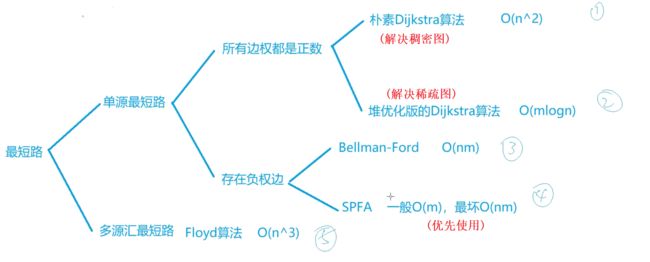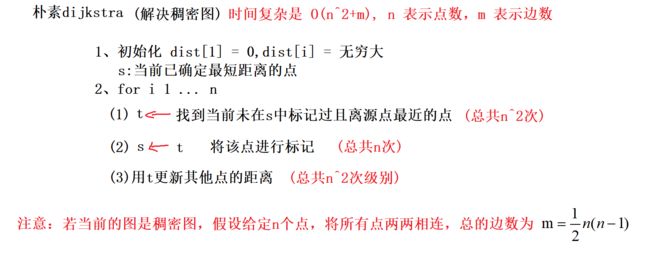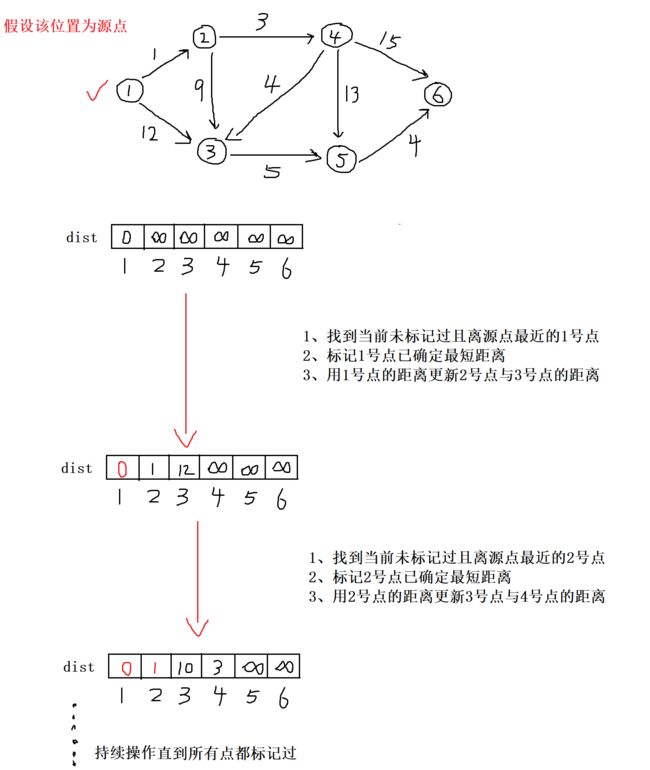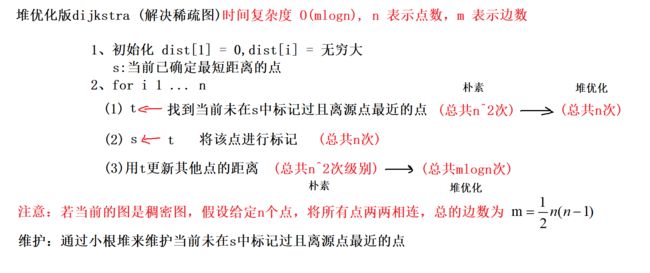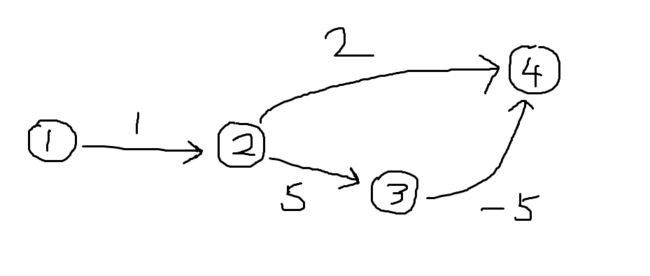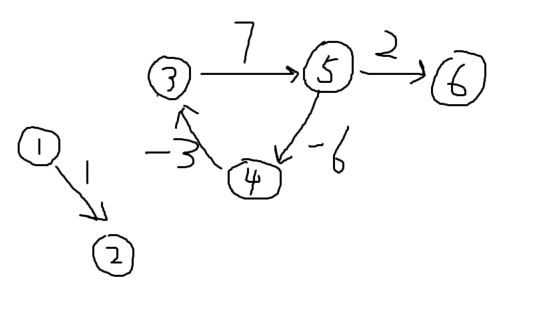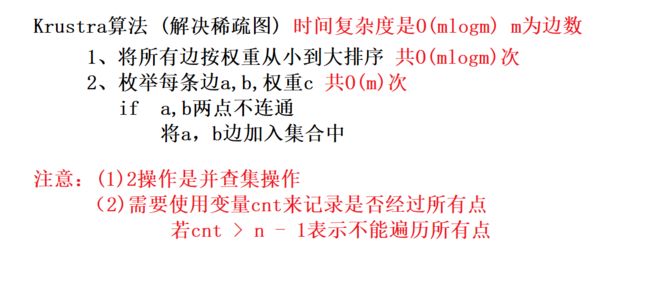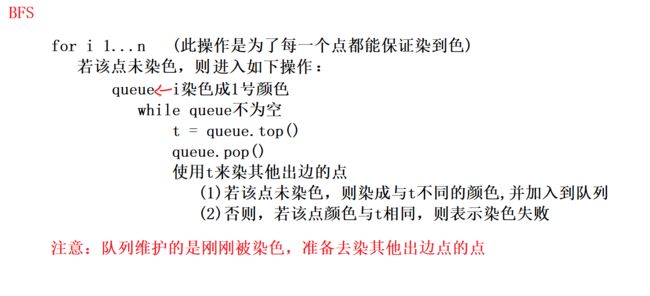1、朴素dijkstra
算法分析
注意:若要求任意点i到任意个点j的最短距离,只需修改dijkstra方法中的起源位置dist[i] = 0,以及返回为dist[j]
时间复杂度
Java 代码
public class Main{
static int N = 510;
static int n;
static int[][] g = new int[N][N];// 存储每条边
static int[] dist = new int[N];// 存储1号点到每个点的最短距离
static boolean[] st = new boolean[N];
static int INF = 0x3f3f3f3f;//设置无穷大
// 求1号点到n号点的最短路,如果不存在则返回-1
public static int dijkstra()
{
Arrays.fill(dist, INF);
dist[1] = 0;
for(int i = 0;i < n;i++)
{
//1、找到当前未标记过且离源点最近的点
int t = -1;
for(int j = 1;j <= n;j++)
{
if(!st[j] && (t == -1 || dist[t] > dist[j]))
t = j;
}
//2、标记该点已经确定最短距离
st[t] = true;
//3、用该点更新其他点的距离
for(int j = 1;j <= n;j++)
{
dist[j] = Math.min(dist[j], dist[t] + g[t][j]);
}
}
if(dist[n] == INF) return -1;
return dist[n];
}
public static void main(String[] args) throws IOException{
BufferedReader reader = new BufferedReader(new InputStreamReader(System.in));
String[] str1 = reader.readLine().split(" ");
n = Integer.parseInt(str1[0]);
int m = Integer.parseInt(str1[1]);
for(int i = 1; i <= n; i++ )
Arrays.fill(g[i], INF);
while(m -- > 0)
{
String[] str2 = reader.readLine().split(" ");
int a = Integer.parseInt(str2[0]);
int b = Integer.parseInt(str2[1]);
int c = Integer.parseInt(str2[2]);
g[a][b] = Math.min(g[a][b], c);//若有重边,选择最短的
}
System.out.println(dijkstra());
}
}
2、堆优化版的dijkstra
算法分析
注意:若要求任意点i到任意个点j的最短距离,只需修改dijkstra方法中的起源位置dist[i] = 0,以及返回为dist[j]
时间复杂度
Java 代码
import java.io.BufferedReader;
import java.io.IOException;
import java.io.InputStreamReader;
import java.util.Arrays;
import java.util.PriorityQueue;
public class Main{
static int N = 100010;
static int n;
static int[] h = new int[N];
static int[] e = new int[N];
static int[] ne = new int[N];
static int[] w = new int[N];
static int idx = 0;
static int[] dist = new int[N];// 存储1号点到每个点的最短距离
static boolean[] st = new boolean[N];
static int INF = 0x3f3f3f3f;//设置无穷大
public static void add(int a,int b,int c)
{
e[idx] = b;
w[idx] = c;
ne[idx] = h[a];
h[a] = idx ++;
}
// 求1号点到n号点的最短路,如果不存在则返回-1
public static int dijkstra()
{
//维护当前未在st中标记过且离源点最近的点
PriorityQueue queue = new PriorityQueue();
Arrays.fill(dist, INF);
dist[1] = 0;
queue.add(new PIIs(0,1));
while(!queue.isEmpty())
{
//1、找到当前未在s中出现过且离源点最近的点
PIIs p = queue.poll();
int t = p.getSecond();
int distance = p.getFirst();
if(st[t]) continue;
//2、将该点进行标记
st[t] = true;
//3、用t更新其他点的距离
for(int i = h[t];i != -1;i = ne[i])
{
int j = e[i];
dist[j] = Math.min(dist[j], distance + w[i]);
queue.add(new PIIs(dist[j],j));
}
}
if(dist[n] == INF) return -1;
return dist[n];
}
public static void main(String[] args) throws IOException{
BufferedReader reader = new BufferedReader(new InputStreamReader(System.in));
String[] str1 = reader.readLine().split(" ");
n = Integer.parseInt(str1[0]);
int m = Integer.parseInt(str1[1]);
Arrays.fill(h, -1);
while(m -- > 0)
{
String[] str2 = reader.readLine().split(" ");
int a = Integer.parseInt(str2[0]);
int b = Integer.parseInt(str2[1]);
int c = Integer.parseInt(str2[2]);
add(a,b,c);
}
System.out.println(dijkstra());
}
}
class PIIs implements Comparable{
private int first;//距离值
private int second;//点编号
public int getFirst()
{
return this.first;
}
public int getSecond()
{
return this.second;
}
public PIIs(int first,int second)
{
this.first = first;
this.second = second;
}
@Override
public int compareTo(PIIs o) {
// TODO 自动生成的方法存根
return Integer.compare(first, o.first);
}
}
3、Bellman_Fore算法
算法分析
1、问题:为什么Dijkstra不能使用在含负权的图中?
分析:如图所示:
若通过Dijkstra算法可以求出从1号点到达4号点所需的步数为3(每次选择离源点最短距离的点更新其他点)
但实际上从1号点到达4号点所需步数为1 (1 --> 2 --> 3),因此不能使用Dijkstra解决含负权图的问题
2、什么是bellman - ford算法?
Bellman - ford算法是求含负权图的单源最短路径的一种算法,效率较低,代码难度较小。其原理为连续进行松弛,在每次松弛时把每条边都更新一下,若在n-1次松弛后还能更新,则说明图中有负环,因此无法得出结果,否则就完成。
(通俗的来讲就是:假设1号点到n号点是可达的,每一个点同时向指向的方向出发,更新相邻的点的最短距离,通过循环n-1次操作,若图中不存在负环,则1号点一定会到达n号点,若图中存在负环,则在n-1次松弛后一定还会更新)
3、bellman - ford算法的具体步骤
for n次
for 所有边 a,b,w (松弛操作)
dist[b] = min(dist[b],back[a] + w)
注意:back[]数组是上一次迭代后dist[]数组的备份,由于是每个点同时向外出发,因此需要对dist[]数组进行备份,若不进行备份会因此发生串联效应,影响到下一个点
4、在下面代码中,是否能到达n号点的判断中需要进行if(dist[n] > INF/2)判断,而并非是if(dist[n] == INF)判断,原因是INF是一个确定的值,并非真正的无穷大,dist[n]大于某个与INF相同数量级的数即可
5、bellman - ford算法擅长解决有边数限制的最短路问题
时间复杂度
其中n为点数,m为边数
Java 代码
import java.io.BufferedReader;
import java.io.IOException;
import java.io.InputStreamReader;
import java.util.Arrays;
public class Main {
static int N = 510;
static int M = 100010;
static int n;//总点数
static int m;//总边数
static int k;//最多经过k条边
static int[] dist = new int[N];//从1到点到n号点的距离
static Node[] list = new Node[M];//结构体
static int INF = 0x3f3f3f3f;
static int[] back = new int[N];//备份dist数组
public static void bellman_ford()
{
Arrays.fill(dist, INF);
dist[1] = 0;
for(int i = 0;i < k;i++)
{
back = Arrays.copyOf(dist, n + 1);//由于是从1开始存到n
for(int j = 0;j < m;j++)
{
Node node = list[j];
int a = node.a;
int b = node.b;
int c = node.c;
dist[b] = Math.min(dist[b], back[a] + c);
}
}
if(dist[n] > INF/2) System.out.println("impossible");
else System.out.println(dist[n]);
}
public static void main(String[] args) throws IOException {
BufferedReader reader = new BufferedReader(new InputStreamReader(System.in));
String[] str1 = reader.readLine().split(" ");
n = Integer.parseInt(str1[0]);
m = Integer.parseInt(str1[1]);
k = Integer.parseInt(str1[2]);
for(int i = 0;i < m;i++)
{
String[] str2 = reader.readLine().split(" ");
int a = Integer.parseInt(str2[0]);
int b = Integer.parseInt(str2[1]);
int c = Integer.parseInt(str2[2]);
list[i] = new Node(a,b,c);
}
bellman_ford();
}
}
class Node
{
int a, b, c;
public Node(int a,int b,int c)
{
this.a = a;
this.b = b;
this.c = c;
}
}
4、spfa算法 最坏:
算法分析
1、什么是spfa算法?
SPFA 算法是 Bellman-Ford算法 的队列优化算法的别称,通常用于求含负权边的单源最短路径,以及判负权环。SPFA一般情况复杂度是 最坏情况下复杂度和朴素 Bellman-Ford 相同,为。
bellman-ford算法操作如下:
for n次
for 所有边 a,b,w (松弛操作)
dist[b] = min(dist[b],back[a] + w)
spfa算法对第二行中所有边进行松弛操作进行了优化,原因是在bellman—ford算法中,即使该点的最短距离尚未更新过,但还是需要用尚未更新过的值去更新其他点,由此可知,该操作是不必要的,我们只需要找到更新过的值去更新其他点即可。
2、spfa算法步骤
queue <-- 1
while queue 不为空
(1) t <-- 队头
queue.pop()
(2)用 t 更新所有出边 t --> b,权值为w
queue <-- b (若该点被更新过,则拿该点更新其他点)
时间复杂度 一般: 最坏:
n为点数,m为边数
3、spfa也能解决权值为正的图的最短距离问题,且一般情况下比Dijkstra算法还好
Java 代码
import java.io.BufferedReader;
import java.io.IOException;
import java.io.InputStreamReader;
import java.util.Arrays;
import java.util.LinkedList;
import java.util.Queue;
public class Main {
static int N = 100010;
static int n;
static int m;
static int[] h = new int[N];
static int[] e = new int[N];
static int[] ne = new int[N];
static int[] w = new int[N];
static int idx = 0;
static int[] dist = new int[N];
static boolean[] st = new boolean[N]; //标记是否在队列中
static int INF = 0x3f3f3f3f;
public static void add(int a,int b,int c)
{
e[idx] = b;
w[idx] = c;
ne[idx] = h[a];
h[a] = idx ++;
}
public static int spfa()
{
Arrays.fill(dist, INF);
Queue queue = new LinkedList();
dist[1] = 0;
queue.add(1);
st[1] = true;//标记1号点在队列中
while(!queue.isEmpty())
{
int t = queue.poll();
st[t] = false;
for(int i = h[t];i != -1;i = ne[i])
{
int j = e[i];//获取点编号
//若该点被更新过,则加入队列中
if(dist[j] > dist[t] + w[i])
{
dist[j] = dist[t] + w[i];
//判断该点是否已经在队列中
if(!st[j])
{
queue.add(j);
st[j] = true;//标记已加入队列
}
}
}
}
return dist[n];
}
public static void main(String[] args) throws IOException {
BufferedReader reader = new BufferedReader(new InputStreamReader(System.in));
String[] str1 = reader.readLine().split(" ");
n = Integer.parseInt(str1[0]);
m = Integer.parseInt(str1[1]);
Arrays.fill(h, -1);
while(m -- > 0)
{
String[] str2 = reader.readLine().split(" ");
int a = Integer.parseInt(str2[0]);
int b = Integer.parseInt(str2[1]);
int c = Integer.parseInt(str2[2]);
add(a,b,c);
}
int t = spfa();
if(t == 0x3f3f3f3f) System.out.println("impossible");
else System.out.println(t);
}
}
5、spfa算法解决负环路问题 最坏:
算法分析
使用spfa算法解决是否存在负环问题
- 1、
dist[x]记录当前1到x的最短距离
- 2、
cnt[x]记录当前最短路的边数,初始每个点到1号点的距离为0,只要他能再走n步,即cnt[x] >= n,则表示该图中一定存在负环,由于从1到x至少经过n条边时,则说明图中至少有n + 1个点,表示一定有点是重复使用
- 3、若
dist[j] > dist[t] + w[i],则表示从t点走到j点能够让权值变少,因此进行对该点j进行更新,并且对应cnt[j] = cnt[t] + 1,往前走一步
注意:该题是判断是否存在负环,并非判断是否存在从1开始的负环,因此需要将所有的点都加入队列中,更新周围的点
时间复杂度 一般: 最坏:
参考文献
Java 代码
import java.io.BufferedReader;
import java.io.IOException;
import java.io.InputStreamReader;
import java.util.Arrays;
import java.util.LinkedList;
import java.util.Queue;
public class Main {
static int n;
static int m;
static int N = 2010;
static int M = 10010;
static int[] h = new int[N];
static int[] e = new int[M];
static int[] ne = new int[M];
static int[] w = new int[M];
static int idx = 0;
static int[] dist = new int[N];//记录当前1到x的最短距离
static int[] cnt = new int[N];//从1到点到x经过的边数
static boolean[] st = new boolean[N];
public static void add(int a,int b,int c)
{
e[idx] = b;
w[idx] = c;
ne[idx] = h[a];
h[a] = idx ++;
}
public static boolean spfa()
{
Queue queue = new LinkedList();
//将所有点进入队列
for(int i = 1;i <= n;i++)
{
queue.add(i);
st[i] = true;
}
while(!queue.isEmpty())
{
int t = queue.poll();
st[t] = false;
for(int i = h[t]; i != -1;i = ne[i])
{
int j = e[i];
if(dist[j] > dist[t] + w[i])
{
dist[j] = dist[t] + w[i];
cnt[j] = cnt[t] + 1;
if(cnt[j] >= n) return true;
if(!st[j])
{
queue.add(j);
st[j] = true;
}
}
}
}
return false;
}
public static void main(String[] args) throws IOException {
BufferedReader reader = new BufferedReader(new InputStreamReader(System.in));
String[] str1 = reader.readLine().split(" ");
n = Integer.parseInt(str1[0]);
m = Integer.parseInt(str1[1]);
Arrays.fill(h, -1);
while(m -- > 0)
{
String[] str2 = reader.readLine().split(" ");
int a = Integer.parseInt(str2[0]);
int b = Integer.parseInt(str2[1]);
int c = Integer.parseInt(str2[2]);
add(a,b,c);
}
if(spfa()) System.out.println("Yes");
else System.out.println("No");
}
}
6、folyd算法
算法分析
(y总真言,简单易懂)
-
f[i, j, k]表示从i走到j的路径上除了i,j以外不包含点k的所有路径的最短距离。那么f[i, j, k] = min(f[i, j, k - 1), f[i, k, k - 1] + f[k, j, k - 1]。
因此在计算第k层的f[i, j]的时候必须先将第k - 1层的所有状态计算出来,所以需要把k放在最外层。
- 读入邻接矩阵,将次通过动态规划装换成从
i到j的最短距离矩阵
- 在下面代码中,判断从a到b是否是无穷大距离时,需要进行if(t > INF/2)判断,而并非是if(t == INF)判断,原因是INF是一个确定的值,并非真正的无穷大,会随着其他数值而受到影响,t大于某个与INF相同数量级的数即可
时间复杂度
Java 代码
import java.io.BufferedReader;
import java.io.IOException;
import java.io.InputStreamReader;
public class Main {
static int n;
static int m;
static int q;
static int N = 210;
static int INF = 0x3f3f3f3f;
static int[][] d = new int[N][N];
public static void floyd()
{
for(int k = 1;k <= n;k++)
for(int i = 1;i <= n;i++)
for(int j = 1;j <= n;j++)
d[i][j] = Math.min(d[i][j], d[i][k] + d[k][j]);
}
public static void main(String[] args) throws IOException {
BufferedReader reader = new BufferedReader(new InputStreamReader(System.in));
String[] str1 = reader.readLine().split(" ");
n = Integer.parseInt(str1[0]);
m = Integer.parseInt(str1[1]);
q = Integer.parseInt(str1[2]);
for(int i = 1;i <= n;i++)
{
for(int j = 1;j <= n;j++)
{
if(i == j) d[i][j] = 0;
else d[i][j] = INF;
}
}
while(m -- > 0)
{
String[] str2 = reader.readLine().split(" ");
int a = Integer.parseInt(str2[0]);
int b = Integer.parseInt(str2[1]);
int c = Integer.parseInt(str2[2]);
d[a][b] = Math.min(d[a][b], c);//若有重边选择短的边
}
floyd();
while(q -- > 0)
{
String[] str3 = reader.readLine().split(" ");
int a = Integer.parseInt(str3[0]);
int b = Integer.parseInt(str3[1]);
int t = d[a][b];
if(t > INF / 2) System.out.println("impossible");
else System.out.println(t);
}
}
}

7、Prim算法
算法分析
时间复杂度
Java 代码
import java.io.BufferedReader;
import java.io.IOException;
import java.io.InputStreamReader;
import java.util.Arrays;
public class Main {
static int n;
static int m;
static int q;
static int N = 510;
static int INF = 0x3f3f3f3f;
static int[][] g = new int[N][N];
static int[] dist = new int[N];//表示到集合的最短距离
static boolean[] st = new boolean[N];
public static int prim()
{
Arrays.fill(dist, INF);
int res = 0;
for(int i = 0;i < n;i++)
{
int t = -1;
for(int j = 1;j <= n;j++)
{
if(!st[j] && (t == -1 || dist[t] > dist[j]))
t = j;
}
if(i != 0 && dist[t] == INF) return INF;
//标记已加入集合
st[t] = true;
if(i != 0) res += dist[t];
//用t更新其他点
for(int j = 1;j <= n;j++) dist[j] = Math.min(dist[j], g[t][j]);
}
return res;
}
public static void main(String[] args) throws IOException {
BufferedReader reader = new BufferedReader(new InputStreamReader(System.in));
String[] str1 = reader.readLine().split(" ");
n = Integer.parseInt(str1[0]);
m = Integer.parseInt(str1[1]);
for(int i = 1;i <= n;i++)
for(int j = 1;j <= n;j++)
{
g[i][j] = INF;
}
while(m -- > 0)
{
String[] str2 = reader.readLine().split(" ");
int a = Integer.parseInt(str2[0]);
int b = Integer.parseInt(str2[1]);
int c = Integer.parseInt(str2[2]);
g[a][b] = Math.min(g[a][b], c);
g[b][a] = Math.min(g[b][a], c);
}
int t = prim();
if(t == INF) System.out.println("impossible");
else System.out.println(t);
}
}
8、Kruskal算法
算法分析
时间复杂度
Java 代码
import java.io.BufferedReader;
import java.io.IOException;
import java.io.InputStreamReader;
import java.util.ArrayList;
import java.util.Arrays;
import java.util.Collections;
import java.util.List;
public class Main {
static int n;
static int m;
static int q;
static int N = 100010;
static int M = 200010;
static int INF = 0x3f3f3f3f;
static int[] h = new int[N];
static int[] e = new int[M];
static int[] ne = new int[M];
static int[] w = new int[M];
static int idx = 0;
static boolean[] st = new boolean[N];
static List list = new ArrayList();
static int[] p = new int[N];
public static void add(int a,int b,int c)
{
e[idx] = b;
w[idx] = c;
ne[idx] = h[a];
h[a] = idx ++;
}
//找到祖宗编号,并进行路径压缩
public static int find(int x)
{
if(x != p[x]) p[x] = find(p[x]);
return p[x];
}
public static int kruskal()
{
int res = 0;
int cnt = 0;//计算走过的边数
Collections.sort(list);
for(int i = 1;i <= n;i++) p[i] = i;
for(PIIs item : list)
{
int a = item.getA();
int b = item.getB();
int w = item.getW();
a = find(a);
b = find(b);
if(a != b)
{
p[a] = b;
res += w;
cnt ++;
}
}
if(cnt < n - 1) return INF;
return res;
}
public static void main(String[] args) throws IOException {
BufferedReader reader = new BufferedReader(new InputStreamReader(System.in));
String[] str1 = reader.readLine().split(" ");
n = Integer.parseInt(str1[0]);
m = Integer.parseInt(str1[1]);
while(m -- > 0)
{
String[] str2 = reader.readLine().split(" ");
int a = Integer.parseInt(str2[0]);
int b = Integer.parseInt(str2[1]);
int c = Integer.parseInt(str2[2]);
add(a,b,c);
list.add(new PIIs(a,b,c));
}
int t = kruskal();
if(t == INF) System.out.println("impossible");
else System.out.println(t);
}
}
class PIIs implements Comparable
{
private int a;
private int b;
private int w;
public int getA()
{
return this.a;
}
public int getB()
{
return this.b;
}
public int getW()
{
return this.w;
}
public PIIs(int a,int b,int w)
{
this.a = a;
this.b = b;
this.w = w;
}
@Override
public int compareTo(PIIs o) {
// TODO 自动生成的方法存根
return Integer.compare(w, o.w);
}
}
9、染色法判定二分图
给定一个n个点m条边的无向图,图中可能存在重边和自环。
请你判断这个图是否是二分图。
- 奇数环:由奇数条边形成的一个环
- 二分图:当且仅当图中不含有奇数环,两个集合内部的内部没有边
算法1
使用bfs
- 约定染的颜色有1颜色和2颜色
时间复杂度
Java 代码
import java.io.BufferedReader;
import java.io.IOException;
import java.io.InputStreamReader;
import java.util.Arrays;
import java.util.LinkedList;
import java.util.Queue;
public class Main {
static int n;
static int m;
static int N = 100010;
static int M = 2100010;
static int[] h = new int[N];
static int[] e = new int[M];
static int[] ne = new int[M];
static int idx = 0;
static int[] color = new int[N];//共1和2两种不同的颜色
static boolean[] st = new boolean[N];
public static void add(int a,int b)
{
e[idx] = b;
ne[idx] = h[a];
h[a] = idx ++;
}
public static boolean bfs()
{
Queue queue = new LinkedList();
for(int i = 1;i <= n;i++)
{
//若该点为染色
if(color[i] == 0)
{
color[i] = 1;
queue.add(i);
while(!queue.isEmpty())
{
int t = queue.poll();
for(int j = h[t] ;j != -1;j = ne[j])
{
int k = e[j];
if(color[k] == 0)
{
color[k] = 3 - color[t];
queue.add(k);
}
else if(color[k] == color[t]) return false;
}
}
}
}
return true;
}
public static void main(String[] args) throws IOException {
BufferedReader reader = new BufferedReader(new InputStreamReader(System.in));
String[] str1 = reader.readLine().split(" ");
n = Integer.parseInt(str1[0]);
m = Integer.parseInt(str1[1]);
Arrays.fill(h, -1);
while(m -- > 0)
{
String[] str2 = reader.readLine().split(" ");
int a = Integer.parseInt(str2[0]);
int b = Integer.parseInt(str2[1]);
add(a,b);
add(b,a);
}
if(bfs()) System.out.println("Yes");
else System.out.println("No");
}
}
算法2
使用dfs(注意:在这里使用java会直接爆栈hh)
- dfs(u,c)表示把u号点染色成c颜色,并且判断从u号点开始染其他相连的点是否染成功
时间复杂度
Java 代码
import java.io.BufferedReader;
import java.io.IOException;
import java.io.InputStreamReader;
import java.util.Arrays;
public class Main {
static int n;
static int m;
static int N = 100010;
static int M = 200010;
static int[] h = new int[N];
static int[] e = new int[M];
static int[] ne = new int[M];
static int idx = 0;
static int[] color = new int[N];//共1和2两种不同的颜色
static boolean[] st = new boolean[N];
public static void add(int a,int b)
{
e[idx] = b;
ne[idx] = h[a];
h[a] = idx ++;
}
//dfs(u,c)表示把u号点染色成c颜色,并且判断从u号点开始染其他相连的点是否成功
public static boolean dfs(int u,int c)
{
color[u] = c;
for(int i = h[u];i != -1;i = ne[i])
{
int j = e[i];
if(color[j] == 0)
{
if(!dfs(j,3 - c)) return false;
}
else if(color[j] == c) return false;//颜色重复
}
return true;
}
public static void main(String[] args) throws IOException {
BufferedReader reader = new BufferedReader(new InputStreamReader(System.in));
String[] str1 = reader.readLine().split(" ");
n = Integer.parseInt(str1[0]);
m = Integer.parseInt(str1[1]);
Arrays.fill(h, -1);
while(m -- > 0)
{
String[] str2 = reader.readLine().split(" ");
int a = Integer.parseInt(str2[0]);
int b = Integer.parseInt(str2[1]);
add(a,b);
add(b,a);
}
boolean flag = true;//标记是否染色成功
for(int i = 1;i <= n;i++)
{
//若未染色
if(color[i] == 0)
{
if(!dfs(i,1))
{
flag = false;
break;
}
}
}
if(flag) System.out.println("Yes");
else System.out.println("No");
}
}
10、匈牙利算法
解决二分图的最大匹配问题
时间复杂度: ,实际运行时间远小于
典型题目
给定一个二分图,其中左半部包含n1个点(编号1~n1),右半部包含n2个点(编号1~n2),二分图共包含m条边。
数据保证任意一条边的两个端点都不可能在同一部分中。
请你求出二分图的最大匹配数。
二分图的匹配:给定一个二分图G,在G的一个子图M中,M的边集{E}中的任意两条边都不依附于同一个顶点,则称M是一个匹配。
二分图的最大匹配:所有匹配中包含边数最多的一组匹配被称为二分图的最大匹配,其边数即为最大匹配数。
输入格式
第一行包含三个整数 n1、 n2 和 m。
接下来m行,每行包含两个整数u和v,表示左半部点集中的点u和右半部点集中的点v之间存在一条边。
输出格式
输出一个整数,表示二分图的最大匹配数。
import java.io.BufferedReader;
import java.io.IOException;
import java.io.InputStreamReader;
import java.util.Arrays;
public class Main {
static int n1;
static int n2;
static int m;
static int N = 510;
static int M = 100010;
static int[] h = new int[N];
static int[] e = new int[M];
static int[] ne = new int[M];
static int idx = 0;
static boolean[] st = new boolean[N];
static int[] match = new int[N];
public static void add(int a,int b)
{
e[idx] = b;
ne[idx] = h[a];
h[a] = idx ++;
}
public static boolean find(int x)
{
for(int i = h[x];i != -1;i = ne[i])
{
int j = e[i];
if(!st[j])
{
st[j] = true;
if(match[j] == 0 || find(match[j]))
{
match[j] = x;
return true;
}
}
}
return false;
}
public static void main(String[] args) throws IOException {
BufferedReader reader = new BufferedReader(new InputStreamReader(System.in));
String[] str1 = reader.readLine().split(" ");
n1 = Integer.parseInt(str1[0]);
n2 = Integer.parseInt(str1[2]);
m = Integer.parseInt(str1[2]);
Arrays.fill(h, -1);
while(m -- > 0)
{
String[] str2 = reader.readLine().split(" ");
int a = Integer.parseInt(str2[0]);
int b = Integer.parseInt(str2[1]);
add(a,b);
}
int res = 0;
for(int i = 1;i <= n1;i++)
{
Arrays.fill(st, false);
if(find(i)) res ++;
}
System.out.println(res);
}
}
